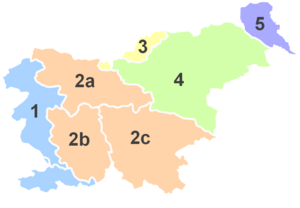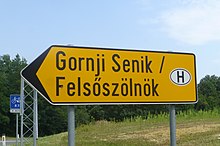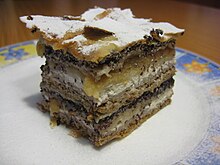Prekmurje
This article has multiple issues.Please helpimprove itor discuss these issues on thetalk page.(Learn how and when to remove these template messages)
|

Prekmurje(Slovene pronunciation:[pɾekˈmúːɾjɛ];[1]dialectically:Prèkmürsko[2]orPrèkmüre;Hungarian:Muravidék) is a geographically, linguistically, culturally and ethnically defined region ofSlovenia,settled bySlovenesand aHungarian minority,lying between theMur RiverinSloveniaand theRába Valley(thewatershedof theRába;Slovene:Porabje) in the westernmost part ofHungary.[3][4]It maintains certain specific linguistic, cultural and religious features that differentiate it from other Slovenian traditional regions. It covers an area of 938 square kilometers (362 sq mi) and has a population of 78,000 people.
Name
[edit]It is named after theMur River,which separates it from the rest of Slovenia (a literal translation fromSlovenewould beOver-MurorTransmurania). InHungarian,the region is known asMuravidék,and inGermanasÜbermurgebiet.
The name Prekmurje was introduced in the twentieth century, although it is derived from an older term. Before 1919, the Slovenian-inhabited lands ofVas Countyin theKingdom of HungaryandAustria-Hungarywere known as theSlovene Marchor "VendicMarch "(in Slovenian:Slovenska krajina,in Hungarian:Vendvidék). The part of modern Prekmurje that belonged toZala County(the area betweenLendava,KobiljeandBeltinci) was not considered to be a part of the Slovenian March. Until the early 19th century, this region of the Zala County belongedecclesiasticallyto theArchdiocese of Zagreband in the legal documents of the Archdiocese it was called as "Transmurania" or "Prekmurje", that is the "territory on the other side of the Mur River". After 1919, this name was reintroduced, now for administrative purposes, by the newYugoslavadministration. It, however, did not gain much popularity among the locals. The name "Slovenian March" was still used by the local inhabitants until the mid-1920s, but was gradually replaced by the term "March of the Mur" (Slovenian:Murska krajina). The current Hungarian name for Prekmurje,Muravidék,dates from the interwar period and is a translation of the SlovenianMurska krajina.From the mid-1930s onward, the name Prekmurje became widely used in the press and eventually became the most common name for the region. AfterWorld War II,this name replaced all previous designations.
Nowadays, the older termVendvidékstill exists in Hungarian, but it is used only for the small settlement area ofHungarian SlovenesbetweenSzentgotthárdand the Slovenian border that remained part of Hungary after 1919.
Geography
[edit]
The region is divided into three geographical subregions: the hilly area to the north ofMurska Sobota,known asGoričko(literally, 'the uplands'); the eastern flatlands along theMur River,known asRavensko(literally, 'the flatlands'), and the western lowlands aroundLendava,known asDolinsko(literally, 'the lowlands'). Northeast of Lendava, there is a small hilly sub-region, known as theLendava Hills(Lendavske gorice).
The administrative and commercial seat of the region is the town ofMurska Sobota.The only other major town is Lendava. Other significant rural centres areBeltinci,Turnišče,Dobrovnik,andČrenšovci.
Population
[edit]
The majority of the inhabitants of the region are ethnicSlovenes.There are also sizableHungarianandRomaniminorities in the region.
In 1921, the total population of the area numbered 92,295, including 74,199 Slovene speakers, 14,065Hungarianspeakers, and 2,540 German speakers. Since then, the number of Hungarian speakers has been falling slowly but steadily. The German-speaking community, which used to be concentrated in three villages near the Austrian border and in Murska Sobota, was eitherexpelledfrom the area or assimilated afterWorld War II.
Since the early 1950s, Hungarian has had co-official status in the traditional settlement area of the Hungarian minority. Three municipalities are completely bilingual—Lendava(Hungarian:Lendva),Hodoš(Hungarian:Őrihodos), andDobrovnik(Hungarian:Dobronak)—and the two municipalities ofŠalovciandMoravske Topliceare only partially bilingual. Two municipalities, Hodoš and Dobrovnik, have a Hungarian majority.
Prekmurje has traditionally been the most heterogeneous Slovene region regarding religious affiliation. Besides aRoman Catholicmajority, there is a significantProtestant(mostlyLutheran) minority, concentrated in the hills of theGoričkoregion, which represents 20 to 25% of the population of Prekmurje. Three municipalities have a Lutheran majority (Puconci,Gornji Petrovci,andHodoš), whereas in theMunicipality of Moravske TopliceLutherans comprise just under half of the population.
BeforeWorld War II,there used to be a significantJewishcommunity as well, mostly concentrated in the towns of Murska Sobota and Lendava (see alsoLendava Synagogue). In the 1930s, two-thirds of all Slovenian Jews lived in Prekmurje. Most of them died in theHolocaust,and many of the survivors madealiyahafter the war. There is also a significantRomanipresence in the region, with Prekmurje being one of the two major settlement areas of Slovenian Romani (the other beingLower Carniola).
History
[edit]

Overview
[edit]The region has had a turbulent history: it has been inhabited since theStone Age,it was later included into theRoman Empireand subsequently into theOdoacer'sKingdom of Italy,the Kingdom of theOstrogoths,the Kingdom of theLombards,the Kingdom of theAvars,the Slavic state ofSamo,theFrankish Empire,thePrincipality of Lower Pannonia(9th century), andArnulf'sKingdom of Carantania(9th-10th century). In the late 10th century it was invaded by the Hungarians and was under administration of the medievalKingdom of Hungaryuntil the 16th century, when former territories of this kingdom were divided between theHabsburg monarchyand theOttoman Empire.Since then, Prekmurje was mostly under administration of the Habsburg Monarchy, with brief periods of Ottoman administration. Following the dissolution of the Habsburg monarchy in 1918, the region was firstly included into theHungarian Democratic Republicand subsequently into theHungarian Soviet Republic.In 1919, it proclaimed independence as the short-livedRepublic of Prekmurjeand was subsequently included into theKingdom of Serbs, Croats and Slovenes(later known asYugoslavia). From 1941 to 1945, Prekmurje wastemporarily occupied by the Axis Powersand in 1945 it was included into the new socialistYugoslavia.Since 1991, it is part of an independentSlovenia.
Antiquity to Middle Ages
[edit]During the Roman administration, the region was part of the province ofPannonia.Although, earlierSlavicsettlements had existed in the area, the ancestors of modern Slovenes moved from easternAlpsand settled in Prekmurje after theFranksdefeated theAvarsduring the reign ofCharlemagne.In the 9th century, this area was part of the Slavic state known as thePrincipality of Lower Pannonia.The center of this state was in the city ofBlatnogradnearLake Balaton.The principality was later dissolved and integrated in the Kingdom of Carantania established by the German EmperorArnulf of Carinthia.This political entity in which all the ancestors of modern Slovenes were united under one ruler was soon destroyed by theHungarianinvaders who conquered thePannonian plainand who incorporated Prekmurje into theKingdom of Hungary.The area inhabited by Slovenes shrank to the present extent by the end of the 12th century and has remained stable since. In the 11th century, during Hungarian administration, the region was part of the Kolon county. Between the 11th century and 1526, it was divided betweenVas CountyandZala County.In the end of the 13th and beginning of the 14th century, during the collapse of the central power in the Kingdom of Hungary, the region was part of the domain of semi-independent oligarchHenrik Kőszegi.
Habsburg Royal Kingdom of Hungary
[edit]
In 1526, the region of Prekmurje came underHabsburgadministration, although some villages were underOttomanadministration during short periods between 1566 and 1688. During Habsburg administration in the 16th and 17th centuries, the region was part of the Captaincy between Lake Balaton and the Drava River within the Habsburg Kingdom of Hungary. For a short time,Beltinci,under the nameBalatin,became the sanjak center of the OttomanKanije Province.In 1687, Vas and Zala counties were restored: with a small interruption from 1849 to 1867, most of Prekmurje belonged to Vas County except for theLendavadistrict, which was part ofZala Countyuntil 1918.
20th century
[edit]After the end ofWorld War Iand dissolution of Habsburg Monarchy, there was briefly an independent Hungarian state and a short-livedRepublic of Prekmurjethat emerged in the midst of the chaos of theHungarian Revolution of 1919.In 1918 the Catholic politicians andJózsef Kleklaimed to create an autonomous entity or independent state, with the nameSlovenska krajina.On August 12, 1919, Yugoslav troops took control of the region, and it was incorporated into the newly establishedKingdom of Serbs, Croats and Slovenes(renamedYugoslaviain 1929). Between 1919 and 1922, the region belonged toMariborcounty, between 1922 and 1929 toMaribor oblast,and between 1929 and 1941 to theDrava BanovinawithLjubljanaas its capital. During World War II, it wasoccupied and annexedby theKingdom of Hungaryfrom 1941 to 1944 and byNazi Germanybetween 1944 and 1945.Soviettroops took control of the area in May 1945. After the war it became part of theSocialist Republic of Slovenia,which was one of the newly formed republics ofYugoslavia.


Administrative divisions
[edit]Prekmurje is part of theMura Statistical Region,also known asPomurjeor the Mura Region, which includes two historical regions: Prekmurje and thePrlekijasub-region.
Prekmurje is divided into 19 municipalities:
- Beltinci
- Cankova
- Črenšovci
- Dobrovnik
- Gornji Petrovci
- Grad
- Hodoš
- Kobilje
- Kuzma
- Lendava
- Moravske Toplice
- Murska Sobota
- Odranci
- Puconci
- Rogašovci
- Šalovci
- Tišina
- Turnišče
- Velika Polana
Languages
[edit]
The majority of the population of Prekmurje uses Slovene, either in its standard form or in thePrekmurje dialect.Some of the local population speaksHungarianorRomani.BeforeWorld War II,German was also present in the region, especially in some areas along the border with Austria. According to the Yugoslav census of 1931, just over 2% of the population of the region spoke German as their native language, and around 12% used Hungarian. After 1945, most of the German speakers either fled or were expelled, and the use of Hungarian has been in slow but constant decline since 1918.
Prekmurje Slovene served as the regional language of the Prekmurje region and of theSlovenes in Hungaryfor a long time. It had a codified standard form and even a small literary corpus of around 200 to 300 works. However, after the 1930s, and especially after the end ofWorld War II,the use of the written Prekmurje dialect steeply declined, but it has never been entirely abandoned.[5][6][7][8]It has continued to be used by a broad range of people and, like other Slovene dialects, has retained its own special features that distinguish it from standard Slovene. Most Slovene speakers in the region, like elsewhere in Slovenia, thus live in a situation ofdiglossia.Although minority languages and the local dialect are still widely used in most spheres of private life, especially in rural areas, standard Slovene is used in education, media, and public life.
Hungarianis used in some border areas, especially aroundLendava.In the officially bilingual areas, Hungarian is recognized by the Slovenian government and is used as the second official language alongside Slovene. In these areas, all public signs are written in both languages, and primary and secondary education isbilingual.
Some of theRoma populationin the region have retainedRomani.Slovenia recognizes Romani as aminority language,but this official recognition has very few consequences in practice. The legal protection of Romani is much weaker than that for Hungarian.
Cuisine
[edit]
The region is known for its distinctive cuisine. Among traditional dishes, the best known are a pork, turnip and millet casserole calledbujta repaand a layered pastry calledprekmurska gibanica.
Notable people
[edit]- Mihael Bakoš,Lutheran preacher and author
- Gregor Balažic,football player
- Evald Flisar,writer
- László Göncz,historian and politician
- Feri Horvat,politician, Chairman of theSlovenian National Assembly(2004)
- Miško Kranjec,writer
- Vlado Kreslin,singer
- Milan Kučan,politician,President of Slovenia(1990–2002)
- Števan Küzmič,Lutheran preacher and author
- Mikloš Küzmič,writer and translator
- Feri Lainšček,writer
- Oto Luthar,historian
- Miki Muster,cartoonist
- Mitja Mörec,football player
- Ana Osterman,politician
- Avgust Pavel,ethnologist and translator
- Mária Pozsonec,politician
- Dušan Šarotar,writer
- Radovan Žerjav,politician, chairman of theSlovenian People's Partyand Minister of Economy of Slovenia
- Nika Zorjan,singer
See also
[edit]- Prekmurje Slovene
- Prekmurje Slovenes
- Slovene March (Kingdom of Hungary)
- Republic of Prekmurje
- Wendish question
- Međimurje
References
[edit]- ^"Slovenski pravopis 2001: Prekmurje".
- ^Források a Muravidék történetéhez/Viri za zgodovino Prekmurja, 292. p.
- ^Zupančič, Jernej (March 2009)."Ob etničnem in državnem robu na slovenskem vzhodu"[On the Ethnic and Statal Margin on Slovenian East](PDF).20. zborovanje slovenskih geografov: Pomurje: trajnostni regionalni razvoj ob reki Muri(in Slovenian and English). Association of Slovenian Geographers. p. 17.ISBN978-961-91456-1-6.Retrieved11 February2011.
- ^"Slovenians in Hungary".Ministry of Foreign Affairs, Government of Slovenia.Retrieved11 February2011.
- ^Lukácsné Bajzek Mária–Mladen Pavčić: A szlovén nyelv
- ^Franc Kuzmič: Bibliografija prekmurskih tiskov 1920-1998, Založba ZRC. 1999.ISBN978-961-6182-78-2.p.
- ^Vilko Novak: Izbor prekmurskega slovstva, Ljubljana 1976. 98. p.
- ^Szijártó Imre: Murán innen, Murántúl (jelenkor.hu)Archived2012-03-19 at theWayback Machine
